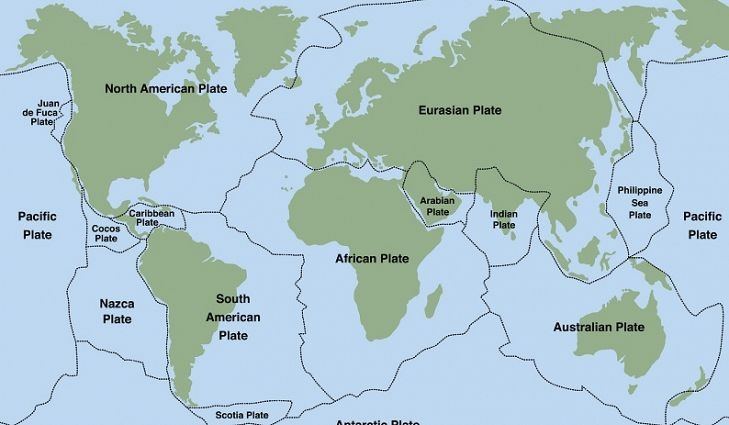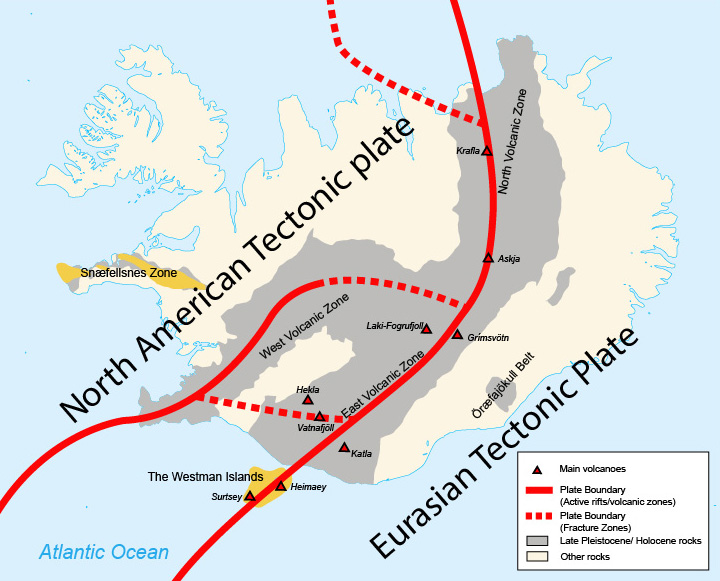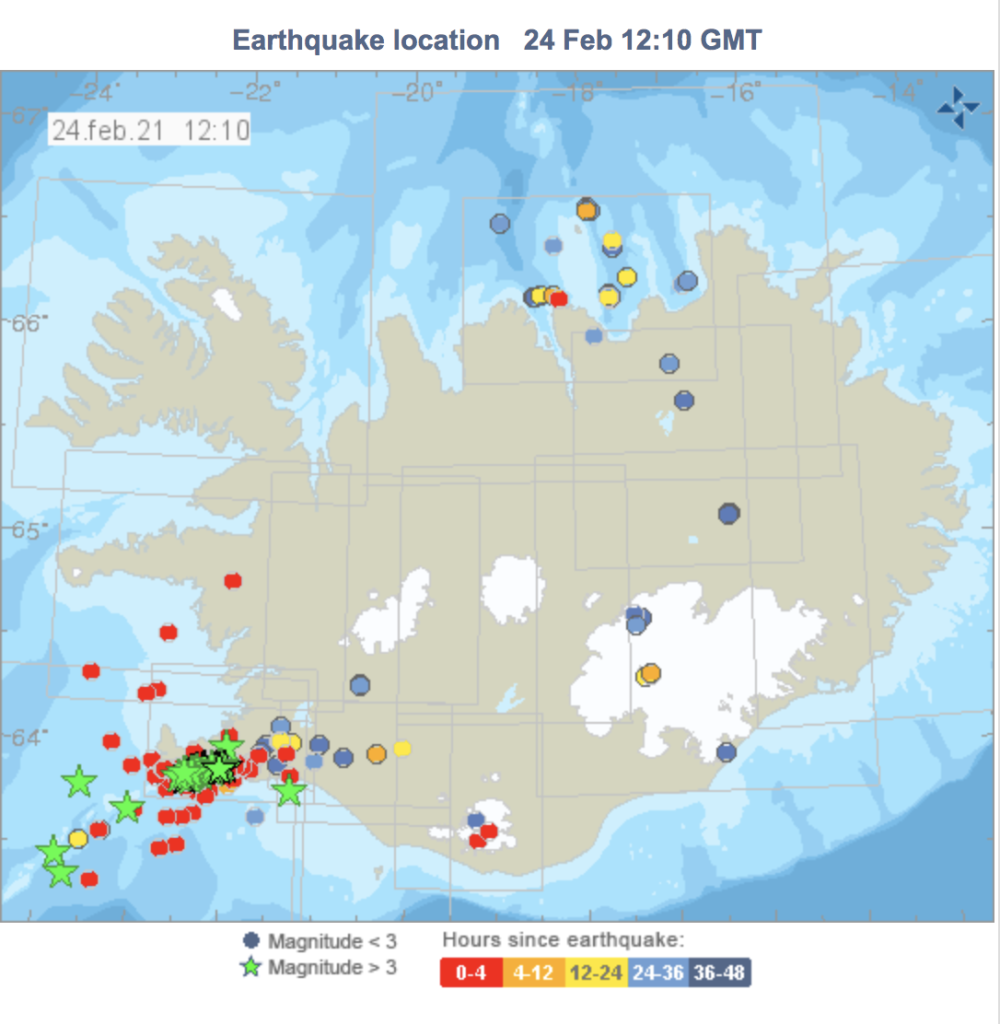Where can I find information about where earthquakes are happening in Iceland?
Earthquakes in Iceland are quite common in certain areas. The earthquakes most commonly happen along the line where the Eurasian and North American tectonic plates meet. On the website of the Icelandic meteorological office you can see a map that shows the locations of current seismic activity: https://en.vedur.is/earthquakes-and-volcanism/earthquakes
The website of the U.S. Geolocical Survey also has interactive maps showing the location and strength of earthquakes happening around the world in realtime:
https://earthquake.usgs.gov/earthquakes/eventpage/us6000dkmk/region-info
Why do earthquakes happen so frequently in Iceland?
An earthquake is what happens when two blocks of the earth suddenly slip past one another. The surface where they slip is called the fault or fault plane. Iceland sits directly on top of the mid-Atlantic Ridge. Half of the country sits on the Eurasian tectonic plate and the other half on the North American tectonic plate. Iceland was formed from these two plates moving apart. Lava flowed out from the mantle, through the gap in the earth’s crust, and formed volcanoes in the ocean. Eventually, these volcanoes grew large enough that they reached the ocean’s surface, and Iceland appeared. Some of Iceland’s volcanoes are still active today, and so new land is constantly being formed. The two tectonic plates are still moving apart, at a rate of about 2.5 centimeters (1 inch) per year. This movement causes seismic activity, and therefore Iceland does experience fairly regular earthquakes.

Map of the world showing tectonic plates
What can I do to be more safe during an earthquake?
There is seldom advance warning of an earthquake. Therefore, it is important to take safety measures ahead of time and to learn how to respond. If needed SMS warning text messages are sent to mobiles phones after earthquakes from the Civil Protection to the affected area
Security measures
- Secure cabinets, shelves and heavy objects to the floor or wall.
- Do not keep heavy objects on top of shelves or on walls.
- Secure heating equipment and radiators. Know where the water main and electric circuit breaker are.
- Secure picture frames and wall light fixtures with closed-loop hangers. Put security latches/child safety latches on cabinet doors.
- Prevent objects from falling on beds.
- Make sure that ceiling panels and raised floors are properly fastened. Cover windows to prevent flying glass in case they are broken. Do not place beds under windows if there is a danger of an earthquake.
- Announcements from the Civil Protection will be made on the State Radio in case of a natural disaster.
Preventive response
It is good to memorize the words DUCK, COVER, HOLD to remember how to react in the event of an earthquake. Those who are indoors when a large earthquake occurs should especially avoid:
- Furniture that may move.
- Objects that may fall from shelves and cabinets (especially in kitchens).
- Radiators that may move.
- Broken glass.
- Falling building parts.
Those who are outside should:
- Find an open space and avoid buildings and electric poles. Keep a safe distance from man-made structures that are as tall or taller than you.
- Duck and cover head (at least with hands) if you cannot get to an open space.
- Avoid falling rocks and gravel slides in mountainous areas.
- Those who are driving should stop their vehicles in a safe place.
After an earthquake, one should:
- Wear shoes (if debris is on the floor).
- Obtain a first aid kit if needed.
- See if anyone is hurt, and if so, call the Emergency Line at 112. If it is not possible to get help by telephone, mark the place of the accident with a flag.
- Turn off the water and heat if a leak is unmanageable, and shut down the main electrical circuit if the building is damaged.
- See if there is a fire and do not use an open flame if there is danger of a fire starting.
- Leave calmly if you think the building is uninhabitable after an earthquake. Many accidents occur when people run out through debris after an earthquake.
- Dress appropriately for the weather conditions (see directions on evacuation) if you leave the building. Remember that the automobile is often the first heated shelter available and it has a radio.
- Remember the emergency shelters in schools run by the Red Cross.
- Listen after announcements from the Civil Protection that are sent to the State Radio see further information in General Instruction and General precautions).
- Never touch damaged electric poles.
- Be prepared for aftershocks.
What are the main earthquake areas in Iceland
Earthquakes are most commonly felt in areas where tectonic plates meet. Sometimes there are even hundreds of earthquakes happening along this line pr.day, but most of them are so small that they can´t be felt except on seismic meters. Earthquakes are quite common in areas along the line where the tectonic plates meet, such as in Reykjanes peninsula and around the mountain Hengill, close to Reykjavík.

Map of Iceland showing tectonic plate boundaries and location of main volcanoes.
How strong are earthquakes in Iceland?
The vast majority of earthquakes in Iceland are so small that they can barely be felt. Some earthquakes are caused by the plate movement, and others are caused by volcanic eruptions.
Here you can see a list of the most recent earthquakes that have happened in Iceland:
https://en.vedur.is/earthquakes-and-volcanism/earthquakes/#view=table
Here you can see a list of the the magnitude and locations of the strongest earthquakes that have been measured in Iceland:
https://earthquaketrack.com/p/iceland/biggest
Interesting facts about earthquakes
- It is estimated that there are 500,000 detectable earthquakes in the world each year. 100,000 of those can be felt, and 100 of them cause damage.
- Most earthquakes occur at depths of less than 80 km (50 miles) from the Earth’s surface.
- The cause of earthquakes was stated correctly in 1760 by British engineer John Michell, one of the first fathers of seismology, in a memoir where he wrote that earthquakes and the waves of energy that they make are caused by “shifting masses of rock miles below the surface”.
- The magnitude of an earthquake is a measured value of the earthquake size. The magnitude is the same no matter where you are, or how strong or weak the shaking was in various locations. The intensity of an earthquake is a measure of the shaking created by the earthquake, and this value does vary with location.
- The world’s deadliest recorded earthquake occurred in 1556 in central China. It struck a region where most people lived in caves carved from soft rock. These dwellings collapsed during the earthquake, killing an estimated 830,000 people. In 1976 another deadly earthquake struck in Tangshan, China, where more than 250,000 people were killed.
- Human beings can detect sounds in the frequency range 20-20,000 Hertz. If a P wave refracts out of the rock surface into the air, and it has a frequency in the audible range, it will be heard as a rumble. Most earthquake waves have a frequency of less than 20 Hz, so the waves themselves are usually not heard. Most of the rumbling noise heard during an earthquake is the building and its contents moving.
- The largest recorded earthquake in the world was a magnitude 9.5 (Mw) in Chile on May 22, 1960.
